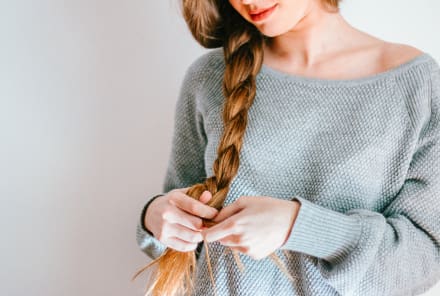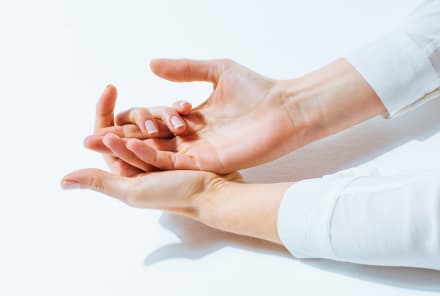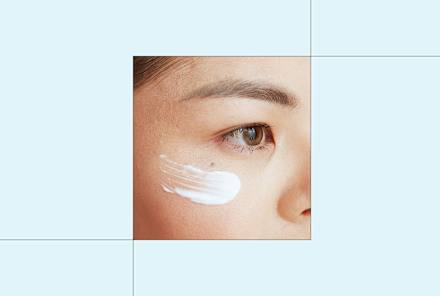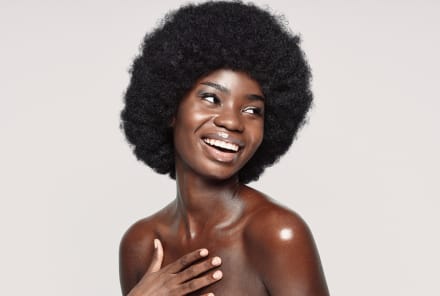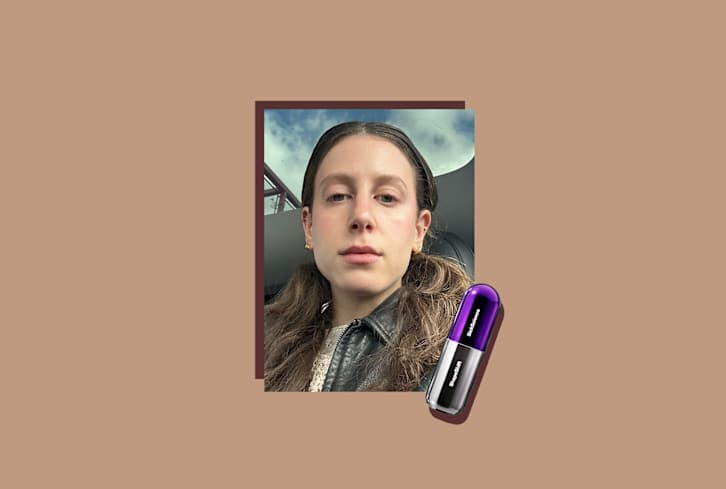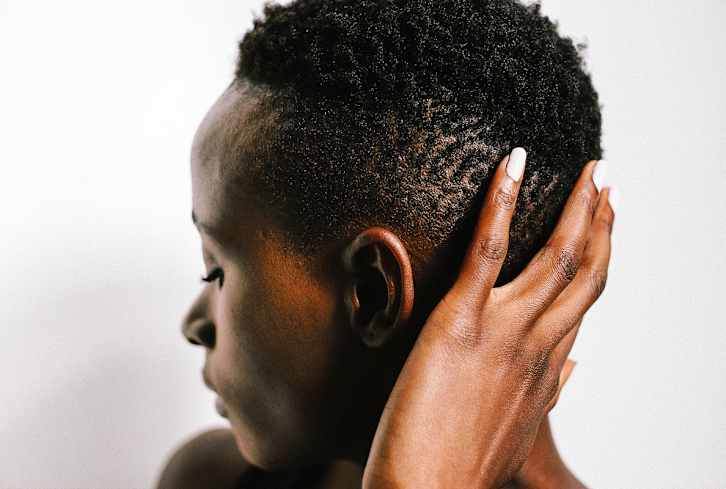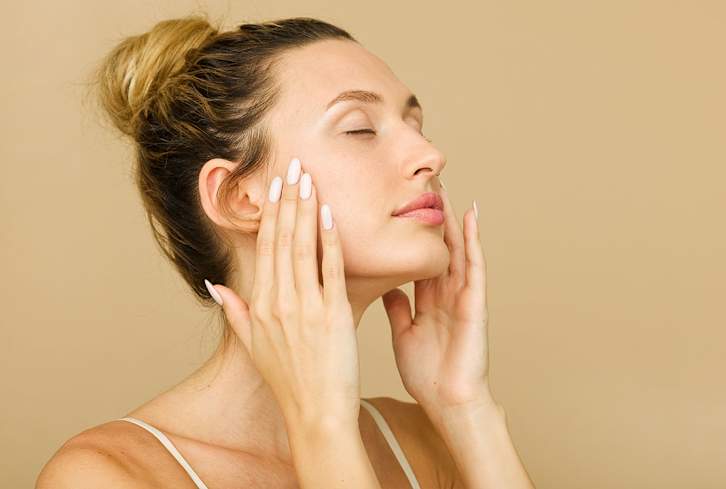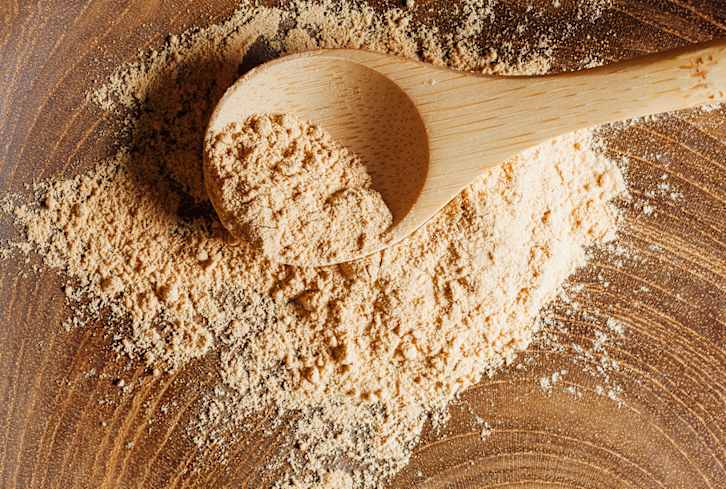Advertisement
This Jade Crystal Massage Will De-Puff Your Whole Face

Don't call it a comeback: Gua sha has been here for years. This ancient Chinese healing technique—pronounced "gwa sa"—has gained traction in the U.S. beauty and wellness scene over the last few years, and because it's potent, easy to DIY, and blends the best of both beauty and good self-care, now it seems gua sha is here to stay.
What is gua sha?
It's a type of massage that incorporates a small stone scraping tool, or board, to help move lymph fluid out of the body and increase circulation. The idea is that the rubbing technique works to clear stagnant energy (otherwise known as "chi" in traditional Chinese medicine) and encourage lymphatic drainage that results in firmer, more toned-looking skin. Although the term broadly refers to the overall bodywork practice—some of the professional body massages can be so vigorous that they result in bruising (here's what a more mellow DIY version is like)—gua sha facials are much more gentle and have become extra popular as they are purported to help create a "natural face-lift" effect.
How to do a gua sha facial.
You'll want to start with a clean face, and for added benefits, first apply your favorite oil or another moisturizer, says mindbodygreen collective member Britta Plug, a holistic esthetician and founder of New York City practice Britta Beauty. Below is her guided instruction, but you may also watch the full tutorial here if you want to follow along with a visual.
Gua sha technique 101.
- Use light pressure with the jade gua sha tool. If the skin starts to get pink or red, it's too firm and not working on the lymph. Lymph responds to light pressure because it is close to the surface. If your pressure is too firm or vigorous, you risk bruising, or "sha" coming up on the skin, so please be gentle with your sweet face!
- Keep the gua sha tool at a 15-degree angle to the skin—almost flat but not quite. This covers more surface and gives a gentle pull on the skin, which is also necessary for the correct technique.
- All of our lymph drains into an area called "terminus" in the little dips right above the middle of each collarbone; we can think of this area as the "dump." The direction of the lymphatic pathways on the face is from the center of the face, out toward the hairline, so we want to move all of the stagnant lymph, or the "trash," out to the outer sides of the face and then sweep it all down the neck to the "dump" above the collarbone.
A step-by-step how-to for doing gua sha facial lymph drainage.
The technique is broken up by focusing on specific areas of the face. Here's how Plug recommends to do it, starting on the right side:
- Down the neck: Start at the outer corner of the jaw, near the earlobe. Sweep down to the dip above the middle of the right collarbone. Repeat 3 to 5 times.
- Under the chin: Sweep from the middle of the soft under-chin (where a double chin would show up) out to the bottom of your earlobe 3 to 5 times.
- Chin: From the middle of the chin, under the lower lip, sweep out to the earlobe 3 to 5 times.
- Cheek: Sweep from the corner of the nose out to the middle ear 3 to 5 times.
- Under-eye: Be especially light and slow here, sweep over the under-eye area, where "eye bags" would show up, and out to the temple, all the way to the hairline 3 to 5 times.
- Under eyebrow: Avoid any pressure on the eye or eyelid itself and stay on the brow bone. Sweep from inner corner out to temple again 3 to 5 times.
- Third eye: Stroke from center of eyebrows up to hairline. This one is especially relaxing for the nervous system and great for insomnia, so do more strokes if it speaks to you! 3 to 10 times.
- Lower forehead: Stroke from center of forehead above the eyebrow out to the temple 3 to 5 times.
- Big sweep. Here we bring everything we've moved to the outer edges of the face all the way back down to the terminus, the collarbone dip located between the center of the neck and the shoulder. Start at the center of the upper forehead, and trace down the hairline, over the temple, then curve behind the ear, and down the side of the neck to terminus3 to 5 times.
- Repeat the whole routine on the second side!
Common mistakes to avoid.
All in all, finding a routine that works for you might be very personal. But here are some common ones you should do your best to avoid:
- Mistake 1: Holding the board at 90 degrees. You want to keep the board almost flat, about "15 degrees from the skin," according to Plug. That's how you can achieve the gentle pulling/tugging effect needed in order to "release tension in the fascia, in the muscles, and in the skin so we can restore optimal flow of your blood, lymph, and chi so that your skin can really start glowing from the inside out." Apply enough pressure to feel an effect; however, be mindful of especially delicate areas, like around the eyes.
- Mistake 2: Repeat each stroke too much or too little. Repeat each stroke at least three times with a maximum of 10. "Five is a good middle ground," says Plug.
- Mistake 3: Not using oil, or using too much oil. You should have enough slip to allow the tool to effortlessly glide across your skin, but be sure to stop once your products settle in; you never want to pull at the delicate skin on your face.
The benefits.
Studies show us that regular facial massages can truly help improve skin quality. For example, one study showed that facial rolling—which lends a similar effect to gua sha—for only five minutes a day improved blood flow to the face1. In another, patients claimed feeling tighter, more supple skin1 after regular massages. (On an overall wellness note, studies do show that massage can also decrease cortisol levels2.) And while we know that obviously, gua sha is meant to help relieve inflammation and encourage lymphatic drainage, the practice may carry surprising other health benefits. Several studies have emerged, ranging from helping to relieve symptoms of perimenopause3, neck pain4, and even migraines5.
What are the best gua sha tools, and which one is right for you?
One reason gua sha has caught on is that the boards themselves are quite glamorous and #shelfie-friendly, plus they're complementary to the wellness world's ongoing obsession with gemstones. The two most popular gua sha stones are rose quartz and jade (the former representing its commercially successful update in the West; the latter being the more traditional material used in TCM). While we have no peer-reviewed studies to back up claims, plenty in the holistic community believe in the healing powers of certain stones, and yes, they are pretty to look at. We asked licensed acupuncturist Elizabeth Trattner, L.Ac., to help us break down the differences:
- Rose quartz: You'll see these everywhere—and also in the facial rollers that are even popping up in your local drugstore beauty aisles—because it's associated with opening the heart chakra. Trattner likes it because "it carries a small charge to help awaken the skin. I like using rose quartz for patients who have issues with stagnation and also hyperpigmentation," she says.
- Jade: "In TCM, jade is referred to as the stone of heaven and represents health, wealth, longevity, and prosperity and is believed to draw out negative energy," says Trattner. "I use jade as my default crystal of choice when working. It has been what practitioners of TCM have used for thousands of years for health and beauty." Anecdotally, many also claim it's good for inflammation and reducing redness.
- Fire agate: This mineral is part of the quartz family and tends to have a "piezoelectric effect, which carry a small charge; however, the energy of a fire agate is different from clear or rose quartz," Trattner says. "Fire agate is also good for helping calm irritated skin and acne," she says. That said, gua sha tools made with fire agate can be a little harder to find.
- Bian stone: These stones originate from a mountain in China that was struck by a meteor and, therefore, is thought to have notable, supercharged benefits: "Bian stone contains over 40 minerals and trace elements. It produces negative ions, so it also has antioxidant properties," says Trattner, who adds that bian is especially helpful for "skin that has been depleted."
- Scolecite: Popularly touted to rid spaces of negative energy, Trattner uses the stone in the form of a wand, or a long, thin gua sha tool primarily used in acupressure. "I use scolecite to detoxify and decongest skin. Scolecite is a softer stone, and wands can be used on acupressure points of the face, and the smooth side can gently decongest puffy eyes," she says.
The take-away.
Making a time to stick with the ritual will help you reap the most results, many experts note. If you want a personal account of what it might do over the course of several weeks, here's what happened when one editor stuck to the practice for two full weeks. One thing we can absolutely get behind: You can't go wrong establishing a daily self-care practice that helps you feel good and look better.

